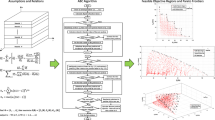Abstract
A genetic algorithm for the optimization of composite laminates is proposed in this work. The well-known roulette selection criterion, one-point crossover operator, and uniform mutation operator are used in this genetic algorithm to create the next population. To improve the hill-climbing capability of the algorithm, adaptive mechanisms designed to adjust the probabilities of the crossover and mutation operators are included, and the elite strategy is enforced to ensure the quality of the optimum solution. The proposed algorithm includes a new operator called the elite comparison, which compares and uses the differences in the design variables of the two best solutions to find possible combinations. This genetic algorithm is tested in four optimization problems of composite laminates. Specifically, the effect of the elite comparison operator is evaluated. Results indicate that the elite comparison operator significantly accelerates the convergence of the algorithm, which thus becomes a good candidate for the optimization of composite laminates.
Similar content being viewed by others
References
H. Ghiasi, D. Pasini and L. Lessard, Optimum stacking sequence design of composite materials Part I: constant stiffness design, Composite Structures, 90 (2009) 1–11.
H. Ghiasi, K. Fayazbakhsh, D. Pasini and L. Lessard, Optimum stacking sequence design of composite materials Part II: variable stiffness design, Composite Structures, 93 (2010) 1–13.
M. K. Apalak, M. Yildirim and R. Ekici, Layer optimisation for maximum fundamental frequency of laminated composite plates for different edge conditions, Composites Science and Technology, 68 (2008) 537–550.
F. Javidrad and R. Nouri, A simulated annealing method for design of laminates with required stiffness properties, Composite Structures, 93 (2011) 1127–1135.
R. L. Haupt and S. E. Haupt, Practical genetic algorithms, Wiley Interscience (1998).
D. Adler, Genetic algorithm and simulated annealing: a marriage proposal, Proceeding of the IEEE International Conference on Neural Network (1993) 1104–1109.
S. V. Wong and A. M. S. Hamouda, Optimization of fuzzy rules design using genetic algorithm, Advances in Engineering Software, 31 (2000) 251–262.
L. Marin, D. Trias, P. Badallo, G. Rus and J. A. Mayugo, Optimization of composite stiffened panels under mechanical and hygrothermal loads using neural networks and genetic algorithms, Composite Structures, 94 (2012) 3321–3326.
B. G. Falzon and A. Faggiani, The use of a genetic algorithm to improve the postbuckling strength of stiffened composite panels susceptible to secondary instabilities, Composite Structures, 94 (2012) 883–895.
P. Badallo, D. Trias, L. Marin and J. A. Mayugo, A comparative study of genetic algorithms for the multi-objective optimization of composite stringers under compression loads, Composites Part B: Engineering, 47 (2013) 130–136.
J. Bardy, X. Legrand and A. Crosky, Configuration of a genetic algorithm used to optimise fibre steering in composite laminates, Composite Structures, 94 (2012) 2048–2056.
M. Kalantari, M. R. Nami and M. H. Kadivar, Optimization of composite sandwich panel against impact using genetic algorithm, International Journal of Impact Engineering, 37 (2010) 599–604.
D. Keller, Optimization of ply angles in laminated composite structures by a hybrid, asynchronous, parallel evolutionary algorithm, Composite Structures, 92 (2010) 2781–2790.
D. Brown, C. Huntley and A. A. Spillane, A parallel genetic heuristics for the quadratic assignment problem. In Proceeding of Third International Conference on Neural Networks (1989) 406–415.
K. C. Tan, Y. Li, D. J. Murray-Smith and K. C. Sharman, System identification and linearization using genetic algorithms with simulated annealing. Proceeding IEEE Genetic Algorithms in Engineering System: Innovations and Applications, Conference publication (1995) 164–169.
I. K. Jeong and J. J. Lee, Adaptive simulated annealing genetic algorithm for system identification. Engineering Applications of Artificial Intelligence, 9 (1996) 523–532.
S. F. Hwang, J. H. Wu and R. S. He, Identification of effecttive elastic constants of composite plates based on a hybrid genetic algorithm, Composite Structures, 90 (2009) 217–24.
S. F. Hwang, J. H. Wu, E. Barkanovs and R. Belevicius, Elastic constants of composite materials by an inverse determination method based on a hybrid genetic algorithm, Journal of Mechanics, 26 (2010) 345–224.
C. C. Lin and Y. J. Lee, Stacking sequence optimization of laminated composite structures using genetic algorithm with local improvement, Composite Structures, 63 (2004) 339–345.
Author information
Authors and Affiliations
Corresponding author
Additional information
Recommended by Associate Editor Heung Soo Kim
Shun-Fa Hwang received his Ph.D. in mechanical engineering from the University of California, Los Angeles, USA, in 1992. He then joined the Faculty of the Mechanical Engineering Department, National Yunlin Univeristy of Science and Technology, Taiwan, and was promoted as a full professor in 2001. His current interests include designing composite structures, digital image correlation, and vibration and sound.
Rights and permissions
About this article
Cite this article
Hwang, SF., Hsu, YC. & Chen, Y. A genetic algorithm for the optimization of fiber angles in composite laminates. J Mech Sci Technol 28, 3163–3169 (2014). https://doi.org/10.1007/s12206-014-0725-y
Received:
Revised:
Accepted:
Published:
Issue Date:
DOI: https://doi.org/10.1007/s12206-014-0725-y




